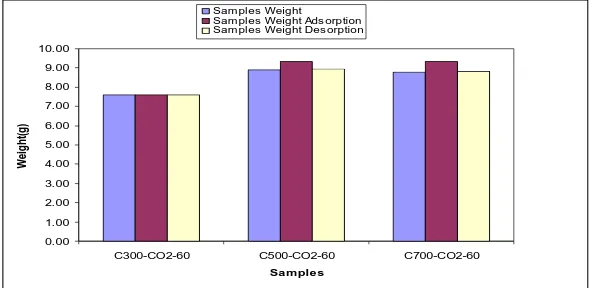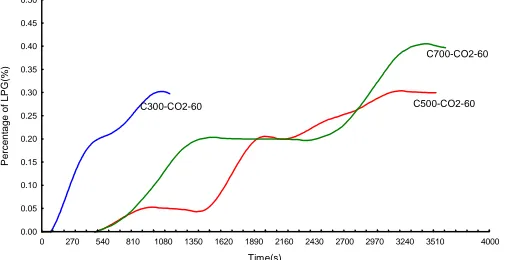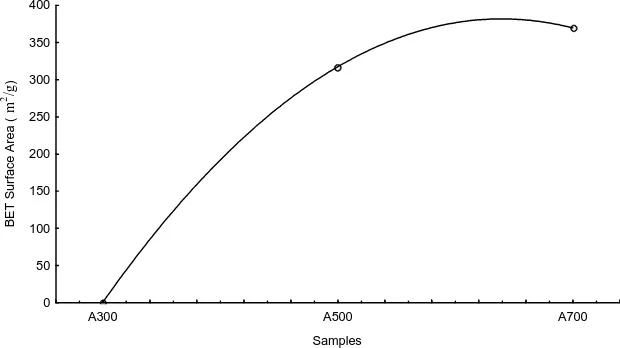Determination the Carbon Adsorbents Effectiveness on Adsorption
and Desorption Processes of LPG
Imanurezeki bin Mohamad1, Safarudin Gazali Herawan1, Mohd Yusoff bin Sulaiman1, and Farid Nasir Ani2
1
Faculty of Mechanical Engineering, Kolej Universiti Teknikal Kebangsaan Malaysia, Locked Bag 1200, 75450 Ayer Keroh, Melaka, Malaysia
2
Faculty of Mechanical Engineering, Universiti Teknologi Malaysia, 81310 UTM Skudai, Johor D.T., Malaysia
1
Email : [email protected]
ABSTRACT
The current research focuses on the experimental investigation of carbon adsorbent produced from oil palm shell as a raw material. These carbon materials can be used for catalyst supports and adsorbents because of its prominent characteristics, such as high surface area, relatively uniform pore size, ordered pore structure and good thermal and mechanical stabilities. The objective of the present research is to develop a liquefied petroleum gas (LPG) gas storage based upon the carbon adsorbents. Carbon adsorbent as a gas storage media for LPG is an alternative way to overcome the disadvantages of pressurized vessel such as high-pressure flammable gas content, dimension of gas tank, and other dangerous aspects. The effect of activation in carbon adsorbent was observed on adsorption and desorption processes of LPG gas. This research will be conducted by designing and developing the experimental rig for preparing carbon adsorbent, which are consisted of a reactor, tube furnace, suction blower and some accessories. Other process, which is activation carried out in a same reactor, which blanketed by tube furnace where the pyrolysis take place. These research aims are used to the extending application of proposed framework to problem arising in the alternative fuel for vehicles.
Keywords: Carbon Adsorbent, LPG, Gas Storage, Adsorption, Desorption
1.0 INTRODUCTION
2002). Potential natural precursors for carbon adsorbents include coconut shells (Auvil, et al., 1993), coal (Mohan et al., 2002), walnut shell, palm date pits ( Al-Attas, 2003) and oil palm shell (Zainuddin, et al., 2005; Herawan, 2000). Their advantages as carbon feed stocks include high density, availability as renewable resources, low cost, low ash content, and they are capable of producing activated carbons of high adsorption capacity.
The research is focused on the experimental investigation of carbon adsorbent, which prepared from oil palm shell as a raw material and other commercial activated carbon for comparison. These carbon materials can be used for catalyst supports and adsorbents because of its prominent characteristics, such as high surface area, relatively uniform pore size, ordered pore structure and good thermal and mechanical stabilities. Herawan (2000) produced carbon adsorbents from oil palm shell in order to achieve the desired application of gas separation such as nitrogen from air or CH4from CO2. This study indicate that the
char modified has a potential for use in O2/N2 separation whereas high temperature char
prepared at 900oC is expected to be useful for the separation of CH4 from CO2/CH4
mixture.
The experimental procedures and results obtained are comprehensively and systematically presented. The objective of the present research is to develop a liquefied petroleum gas (LPG) gas storage based upon the carbon adsorbents from palm oil shell as raw material. Additionally, this research aims are used to overcome the extending application of proposed framework to problem arising in the alternative fuel for vehicles such as LPG and natural gas.
2.0 LIQUEFIED PETROLEUM GAS (LPG)
Liquefied Petroleum Gas (LPG) have been widely used in commercial vehicles, and promising results have been obtained from fuel economy and exhaust emissions points of view (Beer, et al., 2002). LPG can be produced from natural gas and crude oil (Bayraktar and Durgun, 2005; Beer, et al., 2002). Dagaut and Ali (2003) stated that LPG mainly consists of propane and butane, and it may also include different hydrocarbons such as propane, iso-butane and n-butane in various proportions. Bayraktar and Dungun (2005) reported that LPG and other gaseous fuels have common properties that provide them some advantages and disadvantages relative to gasoline. On the basis of these considerations, their work in the case of using LPG in SI engines resulted that, the burning rate of fuel is increased, and thus, the combustion duration is decreased. In recent years, the development of an economical carbon adsorbent has been widely investigated for natural gas storage. Carbon adsorbent as a gas storage media for LPG is an alternative way to overcome the disadvantages of pressurized vessel such as high-pressure flammable gas content, dimension of gas tank, and other dangerous aspects. Hence, the effect of activation in carbon adsorbent was observed during the adsorption and desorption processes of LPG gas.
3.0 METHODOLOGY
curves for hydrocarbon gases that can lead to determine adsorption selectivity for certain gas. The resulting carbon products are defined as;
i) C300 was prepared at 300oC (this char is used as the based char); ii) C500 was prepared at 500oC; and
iii) C700 was prepared at 700oC.
Next stage is preparing activated carbon from char products. By varies the peak temperature, heating rate, and residential time of the sample, the optimization of it can be achieved. This process is carried out in a laboratory scale, single step fixed bed reactor, which blanketed by tube furnace where the pyrolysis take place. Nitrogen gas is used to obtain an inert atmosphere in the reactor and CO2 gas is used to activate the sample. A
suction blower is used to remove volatile matter as well as other gases during the process. The resulting mixed char and plastic bag is defined as; i) C300-10-60 was prepared at 300oC; ii) C500-10-60 was prepared at 500oC; and iii) C700-10-60 was prepared at 700oC.
Final stage, all the sample will be characterized using a constant volume adsorption apparatus (N2 adsorption) is used for determining Average Pore Diameter, Surface area,
Micropore Distribution, Micropore Volume of carbon adsorbent. For application, a carbon adsorbent test bed is used to observe the adsorptive and desorptive capacity of hydrocarbon gas at carbon adsorbent. The resulting of analysis is reviewed as; i) C300-CO2-60 was C500-CO2-60 adsorbed 0.42 g gas and C300-CO2-60 adsorbed 0.02 g gas.
Figure 1: The samples weight on conditions: Before Adsorption, Adsorption, and Desorption
Figure 2 shows the adsorption of LPG with different temperature of activated char. In all cases, activated chars reach their maximum adsorption, however, in certain time the adsorption is inconsistent. This dependence is a result of selected temperature of CO2
activation and residence time. The results indicate that the increasing of temperature will increase the adsorption process. The sample activated carbon C700-CO2-60 have a good adsorbed component tends to the stable adsorption value that show it takes a long time to
reach 0.5% gas in 685 seconds (s) and to maximum adsorption 0.4% gas in 3610 s. Meanwhile, sample C300-CO2-60 show that this carbon adsorbent has small opened pore which is desirable to a gas since it just take short time to reach 0.5% gas in 205 s. Sample C500-CO2-60 shows an average adsorption action and unstable that takes 645 s to reach 0.5%. It might be happened since this sample is adsorbents of nonporous solids with an almost completely uniform surface that not all of its adsorbent has a good adsorption capability that result the data inconsistent.
Figure 2: Graph Activated Carbon Due LPG gas Adsorption
The results of the desorption process from the various samples are shown in Figure 3. From the graph it is apparent that the samples which have a good adsorption capability does not mean that the samples have a good desorption capability. For instance, Sample C300-CO2-60 has small value of adsorption however, shows a good behavior in desorption of LPG gas, which takes 1210 s to reach 0% gas. Sample C700-CO2-60 demonstrated slow action of desorption process that takes 1595 s to reach 0% gas. This results was confirmed that the desorption of carbon adsorbents follow the breakthrough curve pattern, which start from 0% and will increase to maximum 0.25% gas and then decrease until 0% gas. Sample C300-CO2-60 takes short times to desorb since it just adsorbed a small volume of LPG gas during adsorption process, while sample C700-CO2-60 takes longer time to desorb because its adsorbed more volume of LPG gas than other samples. These result supports by BET surface area analysis using micrometric ASAP 2010, that show C700-CO2-60(A700) has 369.5947 m2/g, and follow by decreased number of BET surface area result continue with samples C500-CO2-60(A500) with 317.35 m2/g and C300-CO2-60(A300) with 0.3175 m2/g, which are shown in Figure 4.
Figure 3: Graph Activated Carbon Due LPG gas Desorption
0 270 540 810 1080 1350 1620 1890 2160 2430 2700 2970 3240 3510 4000
Time(s)
0 200 400 600 800 1000 1200 1400 1600 1800
Figure 4: Graph Result BET Surface Area for samples
5.0 CONCLUSIONS
It has been demonstrated that the activation process in carbon adsorbent indeed affects the capacity of LPG adsorption. In this regard, the higher peak temperature can contribute more capability to adsorb LPG gas. The best sample is C700-CO2-60 which shows a higher capability to adsorb LPG and consistent data than the other samples. The desorption of carbon adsorbents follow the breakthrough curve pattern, as similar with a normal distribution curve. It is recognized that the smaller amount of LPG adsorbed in the carbon adsorbent, the faster desorption process occurs, and more amount of LPG adsorbed in the carbon adsorbent, results takes longer time to desorb the gas
ACKNOWLEDGEMENTS
This study was funded by a grant from Ministry of Higher Education.
REFERENCES
1. Al-Attas, O. G. O. The Production of Activated Carbon from Local Palm-Data Pits
for Pollution Removal Process. Master Thesis. King Fahd University of Petroleum
and Minerals. 137pp. (2003).
2. Auvil, Steven R., Schork, Joan M. and Srinivasan, R. Air Separation by Pressure
Swing Adsorption With A High Capacity Carbon Molecular Sieve. (U.S. Patent No.
5240474.) (1993).
3. Bayraktar, H., and Durgun, O. Investigating the effects of LPG on spark ignition engine combustion and performance. Energy Conversion and Management. 46: 2317-2333 (2005).
4. Beer, T., Grant, B., Williams, D., and Watson, H. Fuel-cycle greenhouse gas emissions from alternative fuels in Australian heavy vehicles. Atmos Environ; 36: 753-763 (2002).
5. Dagaut, P., and Ali, H. Kinetics of exidation of a LPG blend mixture in a JSR: Experimental and modeling study. Fuel; 82: 475-480 (2003).
6. Herawan, S. G. Characterisation and Analysis of Carbon Molecular Sieve from Oil
Palm Shell. Master Thesis. Universiti Teknologi Malaysia (2000).
7. Mohan, S. V., Raoa, N. C., and Karthikeyan, J. Adsorptive removal of direct Azo dye from aqueaous phase onto coal base sorbents: A kinetic and mechanistic study. J.
Hazard. Mater., 90: 189-204 (2002).
8. Zainudin, N. F., Lee, K. T., Kamaruddin, A. H., Bhatia, S., and Mohamed, A. R. Study of adsorbent prepared from oil palm ash (OPA) for flue gas desulfurization.


